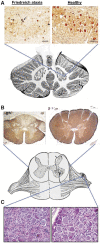Central Nervous System Therapeutic Targets in Friedreich Ataxia
- PMID: 33238751
- PMCID: PMC7757690
- DOI: 10.1089/hum.2020.264
Central Nervous System Therapeutic Targets in Friedreich Ataxia
Abstract
Friedreich ataxia (FRDA) is an autosomal recessive inherited multisystem disease, characterized by marked differences in the vulnerability of neuronal systems. In general, the proprioceptive system appears to be affected early, while later in the disease, the dentate nucleus of the cerebellum and, to some degree, the corticospinal tracts degenerate. In the current era of expanding therapeutic discovery in FRDA, including progress toward novel gene therapies, a deeper and more specific consideration of potential treatment targets in the nervous system is necessary. In this work, we have re-examined the neuropathology of FRDA, recognizing new issues superimposed on classical findings, and dissected the peripheral nervous system (PNS) and central nervous system (CNS) aspects of the disease and the affected cell types. Understanding the temporal course of neuropathological changes is needed to identify areas of modifiable disease progression and the CNS and PNS locations that can be targeted at different time points. As most major targets of long-term therapy are in the CNS, this review uses multiple tools for evaluation of the importance of specific CNS locations as targets. In addition to clinical observations, the conceptualizations in this study include physiological, pathological, and imaging approaches, and animal models. We believe that this review, through analysis of a more complete set of data derived from multiple techniques, provides a comprehensive summary of therapeutic targets in FRDA.
Keywords: Friedreich ataxia; cerebellum; corticospinal system; frataxin; neuroanatomy; proprioceptive system.
Conflict of interest statement
No competing financial interests exist.
Figures

References
-
- Pandolfo M. Friedreich ataxia: the clinical picture. J Neurol 2009;256 Suppl 1:3–8 - PubMed
-
- Campuzano V, Montermini L, Molto MD, et al. . Friedreich's ataxia: autosomal recessive disease caused by an intronic GAA triplet repeat expansion. Science 1996;271:1423–1427 - PubMed
-
- Yandim C, Natisvili T, Festenstein R. Gene regulation and epigenetics in Friedreich's ataxia. J Neurochem 2013;126 Suppl 1:21–42 - PubMed
Publication types
MeSH terms
LinkOut - more resources
Full Text Sources
Medical
Research Materials
